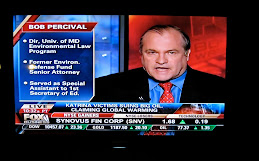Classes started last week at the University of Maryland Carey School of Law. I have a wonderfully diverse group of students in my flagship Environmental Law survey course. This year for the first time I also will be teaching a Special Topics course in Environmental Law for undergraduates on our College Park campus. That course will start tomorrow.
In the last few weeks three federal district courts in the U.S. have weighed in on legal challenges to EPA’s new rule clarifying the reach of federal jurisdiction over “waters of the United States.” EPA is attempting to clear up enormous confusion that has prevailed since the U.S. Supreme Court split 4-1-4 in the Rapanos v. U.S. cases in 2006. In that decision Chief Justice Roberts expressly invited EPA to issue new rules clarifying the reach of its jurisdiction and indicated that they would be entitled to deference under the Court’s Chevron doctrine. On August 26 Judge Irene Keeley of the Northern District of West Virginia dismissed a lawsuit challenging the new rule on the grounds that it should have been brought in the U.S. Court of Appeals. On August 27 Judge Lisa Wood of the Southern District of Georgia dismissed another lawsuit challenging the rules on the same rationale. However, on August 27 Judge Ralph Erickson of the federal district court for North Dakota issued an injunction blocking the rules from taking effect in the 13 states who has sued in his court. The Clean Water Act gives the courts of appeals jurisdiction to hear challenges to “any effluent limitation or other limitation”. Judges Keeley and Wood declared that the EPA rules fall into the category of “other limitation,” but Judge Erickson disagreed because it “places no new burden or requirements on the States.” Why he went on to find that it would cause the states irreparable harm justifying an injunction is hard to understand.
As reported in this bog on August 8, on August 6 an Australian court reversed approval of the Carmichael Coal Mine and Rail Project that environmentalists argued will threaten the Great Barrier Reef. The decision was based on the Environment Department’s failure to consider impacts on endangered reptiles in the vicinity of the project. Angered by the decision, Prime Minister Tony Abbott is now pushing legislation to prevent judicial review of similar lawsuits by environmentalists. He is arguing that otherwise Australia will be paralyzed by “lawfare,” a curious new term that he claims characterizes the U.S. legal system where environmentalists are able to use litigation to tie up the government in knots.
On August 19 I was interviewed live on the Australian Broadcasting Company’s nightly news program “The World.” Anchor Beverley O’Connor interviewed me about the decision by the U.S. government to allow Royal Dutch Shell to drill for oil in the Chukchi Sea off the northern coast of Alaska. The interviewed is online at: http://iview.abc.net.au/programs/world/NU1512H165S00#playing, but unfortunately the link apparently is only viewable from Australia.
Last week Shell suspended its drilling in the Arctic due to an impending storm that was predicted to bring high winds expected to produce very heavy seas. Next week President Obama will visit Alaska to emphasize the impact climate change is having on that state.
On August 17, Norway’s sovereign wealth fund announced that it would exclude four companies from its investment portfolio because they were insufficiently green. The fund barred investments in South Korea’s Posco and Daewoo International Corporation and Malaysia’s IJM Corporation Bhd. and Genting Bhd. The fund explained that it made the decisions “due to an unacceptable risk that the companies are responsible for severe environmental damage as a result of conversion of tropical forest into oil palm plantations.” These companies join a list of more than 60 other companies who have been placed off limits for investments by the fund for reasons including that their activities cause environmental damage or that they produce land mines, tobacco, nuclear weapons, or violate human rights.
On Thursday I leave for Jakarta, Indonesia, where I will be participating in the 13th annual Colloquium of the IUCN Academy of Environmental Law from September 7-12. Two Maryland law students, a recent grad, and my summer global environmental justice fellow will be presenting papers along with me at the conference. We also are bringing Maryland law filmmaker John Brosnan to produce a film of the conference.

















